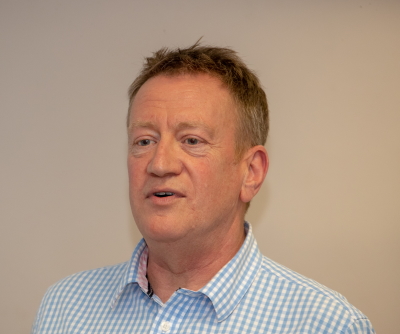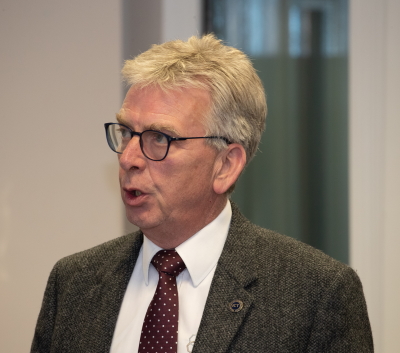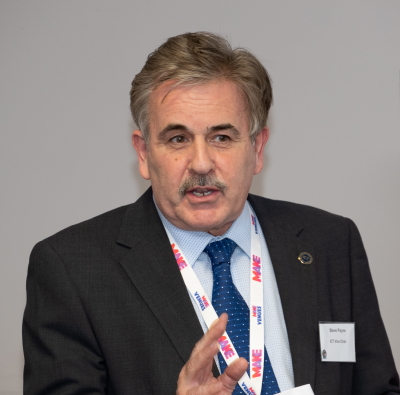Institute of Circuit Technology Evening Seminar
Woodland Grange Hotel, Leamington Spa
Tuesday, 26th February 2019
 As the sun set on a glorious February day, which could easily have been moved from Spring to give us foretaste that better weather was on its way, the Institute of Circuit Technology hosted its first 2019 seminar at the Woodland Grange Hotel in Royal Leamington Spa in the Midlands of England.
As the sun set on a glorious February day, which could easily have been moved from Spring to give us foretaste that better weather was on its way, the Institute of Circuit Technology hosted its first 2019 seminar at the Woodland Grange Hotel in Royal Leamington Spa in the Midlands of England.
The diverse programme of four presentations was introduced by ICT Chairman, Professor Andy Cobley, of Coventry University, who stood in for Bill Wilkie, who had been taken ill at short notice. Andy thanked Bill for his hard work in organising the seminar. He also noted that Pete Starkey was recovering from a recent accident and wished him a speedy recovery.
The first presentation was on ‘Bioleaching of Metals from PCBs’, and was given by Dr Mahsa Baniasadi of Coventry University. The project had been supported by Innovate UK and had an industrial partner. The potential for metal recovery from electronic waste (WEEE) was highlighted, given that there were around 44.7 metric tonnes of WEEE produced annually around the world. A comparison of the metal contents of PCBs and ores was shown, to highlight the potential for recovering metals from such waste. The conventionally used pyro- and hydro-metallurgical recovery methods were described, but more sustainable approaches were needed. Bioleaching was one such method and relied on the production of acids and ligands via the use of micro-organisms. The mechanisms employed were detailed; for example, biocyanidisation could be used for gold recovery, using cyanogenic bacteria to produce the requisite cyanide. The microorganisms could also be used to subsequently degrade the cyanide. The chemical reaction of the metal cyanide complex formation reaction was shown and comparisons had been made between biocyanidation and chemical cyanidation approaches. The bio process had a lower cost and a life cycle assessment had been undertaken. ‘Non-metal content’ removal was an important prerequisite for metal recovery and this was described; it could include the use of a shaking table and electrostatic separation. Data for base metal recovery was also presented and the effect of operational parameters was reviewed. Key factors impacting the recovery efficiency included the glycine concentration, pH, pulp-density, dissolved oxygen levels and particle size. Finally, a commercial metal extraction approach known as the ‘Merrill Crowe’ process was described and this used activated carbon, ion exchange and electrowinning. Download pdf of slide show
 The second presentation was on ‘Soluboard – a New Composite for Electronics’ and this was given by Jonathan Swanston of Jiva Materials. The Jiva company was only just over a year old and its aim was to redefine the way printed circuits were made, with particular emphasis on a fully recyclable PCB laminate that could replace FR4. The problems with end-of-life PCBs, and their traditional methods of treatment, were detailed. These included the release of toxins into the environment. The new product was called Soluboard and it was based on the use of a natural fibre reinforced composite and a soluble polymer which dissolved in hot water. The product was flame retarded using phosphorus based material, fully biodegradable and non-toxic. The potential market for the product in the context of the overall substrate market was described and the current focus was supplying to EU instrumentation makers, where there was said to be a lot of interest. The current price was around £20.00 per square metre and the aim was also to supply it to domestic appliance manufacturers. The company was currently working with Printed Electronics Limited (PEL) and Loughborough University and proof of concept had been demonstrated. The key properties were favourably compared to those of FR4.
The second presentation was on ‘Soluboard – a New Composite for Electronics’ and this was given by Jonathan Swanston of Jiva Materials. The Jiva company was only just over a year old and its aim was to redefine the way printed circuits were made, with particular emphasis on a fully recyclable PCB laminate that could replace FR4. The problems with end-of-life PCBs, and their traditional methods of treatment, were detailed. These included the release of toxins into the environment. The new product was called Soluboard and it was based on the use of a natural fibre reinforced composite and a soluble polymer which dissolved in hot water. The product was flame retarded using phosphorus based material, fully biodegradable and non-toxic. The potential market for the product in the context of the overall substrate market was described and the current focus was supplying to EU instrumentation makers, where there was said to be a lot of interest. The current price was around £20.00 per square metre and the aim was also to supply it to domestic appliance manufacturers. The company was currently working with Printed Electronics Limited (PEL) and Loughborough University and proof of concept had been demonstrated. The key properties were favourably compared to those of FR4.
 The third presentation was called ‘Developing universal solutions to automotive materials challenges’ and was given by Alun Morgan of Ventec. Alun had very kindly stepped in at the last minute to replace the scheduled speaker, Emma Hudson, who had unexpectedly been called away on a business trip. Alun began by outlining the automotive application hot spots requiring thermal management and described LED lighting and its advantages, such as lower power consumption and long lifetime. Haitz’s law was outlined and it described how the cost per lumen fell by a factor of 10 per decade and, for a given wavelength, the amount of light generated per package increased by a factor of 20. He then introduced the basic thermodynamics and outlined the principles of the first, second, third and “zeroth” laws. The principles of the transfer of heat were also described and convection, conduction and radiation were detailed in the context of LED thermal management. LEDs were more efficient than incandescent lamps, but almost 75% of the input electrical power was turned to heat. The conventional methods of managing the heat from LEDs included the use of heatsinks but there were other important methods including the use of thermally conductive PCBs that had enhanced thermal properties compared to FR4. The thermal conductivities of a range of well known materials were listed, and the equations relating to convective and radiative heat transfer were shown, along with an example calculation model for thermal radiation. The critical importance of being able to survive thermal cycling, e.g. in a headlamp unit, was illustrated through the use of two case studies where failure had occurred. Failure analysis had shown that the CTE mismatch between various materials used in the construction had been the likely cause. The problem had been resolved by using materials with more closely matched CTEs and by optimising moduli. The future requirements were illustrated by reference to the published industry roadmaps.
The third presentation was called ‘Developing universal solutions to automotive materials challenges’ and was given by Alun Morgan of Ventec. Alun had very kindly stepped in at the last minute to replace the scheduled speaker, Emma Hudson, who had unexpectedly been called away on a business trip. Alun began by outlining the automotive application hot spots requiring thermal management and described LED lighting and its advantages, such as lower power consumption and long lifetime. Haitz’s law was outlined and it described how the cost per lumen fell by a factor of 10 per decade and, for a given wavelength, the amount of light generated per package increased by a factor of 20. He then introduced the basic thermodynamics and outlined the principles of the first, second, third and “zeroth” laws. The principles of the transfer of heat were also described and convection, conduction and radiation were detailed in the context of LED thermal management. LEDs were more efficient than incandescent lamps, but almost 75% of the input electrical power was turned to heat. The conventional methods of managing the heat from LEDs included the use of heatsinks but there were other important methods including the use of thermally conductive PCBs that had enhanced thermal properties compared to FR4. The thermal conductivities of a range of well known materials were listed, and the equations relating to convective and radiative heat transfer were shown, along with an example calculation model for thermal radiation. The critical importance of being able to survive thermal cycling, e.g. in a headlamp unit, was illustrated through the use of two case studies where failure had occurred. Failure analysis had shown that the CTE mismatch between various materials used in the construction had been the likely cause. The problem had been resolved by using materials with more closely matched CTEs and by optimising moduli. The future requirements were illustrated by reference to the published industry roadmaps.
 The final presentation of the evening, entitled ‘Back to Basics’, was given by Ian Mayoh of Ventec, who began by giving a description of PCB base materials and detailing the various types of resins systems and why they were used. He then discussed the range of glasses and other reinforcements: for example, D glass and NE glass both found use in low loss/high speed applications. He used a schematic to show the production process stages for base materials. The brominated flame retardants and alternative organo-phosphorus materials were described and their functional mechanisms were explained. In recent years, there had been a move away from the use of dicyandiamide curing agents to the phenolic-based systems, which were needed to provide compatibility with the higher temperatures encountered with lead-free soldering. He presented data showing the differences in laminate thermal expansion below and above the glass transition temperature (Tg) and explained techniques for measuring Tg such as differential scanning calorimetry (DSC) and thermo-mechanical analysis (TMA). He discussed the dielectric properties of the various materials used in making a laminate and reviewed the effects of dielectric constant on board design and signal integrity. Copper foil profile was another increasingly important consideration, particularly for boards working at higher frequencies where the skin effect meant conduction was only in the outer few microns of the copper. Again, the presentation concluded with reference to future substrate trends as recorded in the latest industry roadmaps.
The final presentation of the evening, entitled ‘Back to Basics’, was given by Ian Mayoh of Ventec, who began by giving a description of PCB base materials and detailing the various types of resins systems and why they were used. He then discussed the range of glasses and other reinforcements: for example, D glass and NE glass both found use in low loss/high speed applications. He used a schematic to show the production process stages for base materials. The brominated flame retardants and alternative organo-phosphorus materials were described and their functional mechanisms were explained. In recent years, there had been a move away from the use of dicyandiamide curing agents to the phenolic-based systems, which were needed to provide compatibility with the higher temperatures encountered with lead-free soldering. He presented data showing the differences in laminate thermal expansion below and above the glass transition temperature (Tg) and explained techniques for measuring Tg such as differential scanning calorimetry (DSC) and thermo-mechanical analysis (TMA). He discussed the dielectric properties of the various materials used in making a laminate and reviewed the effects of dielectric constant on board design and signal integrity. Copper foil profile was another increasingly important consideration, particularly for boards working at higher frequencies where the skin effect meant conduction was only in the outer few microns of the copper. Again, the presentation concluded with reference to future substrate trends as recorded in the latest industry roadmaps.
 The meeting was closed by Steve Payne, who invited members of the ICT to participate more by considering submitting papers to the ICT journal or by joining the ICT Council. He asked the audience to thank the four speakers for their excellent presentations. Finally, Steve asked the attendees to offer their thanks to Ventec International for the kind sponsorship of the seminar, and the response was a loud round of applause.
The meeting was closed by Steve Payne, who invited members of the ICT to participate more by considering submitting papers to the ICT journal or by joining the ICT Council. He asked the audience to thank the four speakers for their excellent presentations. Finally, Steve asked the attendees to offer their thanks to Ventec International for the kind sponsorship of the seminar, and the response was a loud round of applause.
Martin Goosey
26th February 2019
Footnote: I most gratefully acknowledge the efforts of Professor Martin Goosey in preparing this review, and of Alun Morgan for providing the photographs. Many thanks! Pete Starkey.
